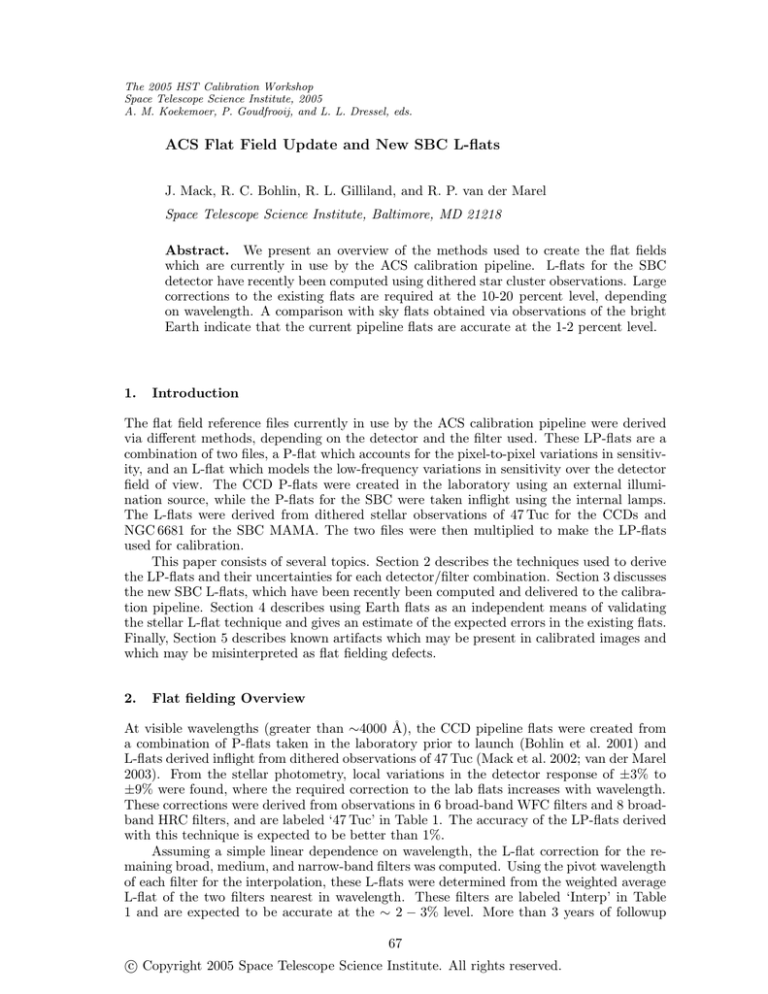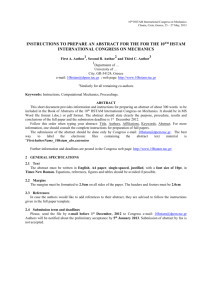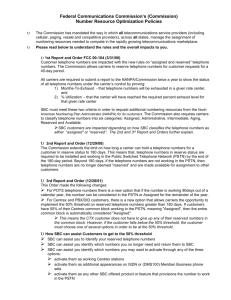
The 2005 HST Calibration Workshop
Space Telescope Science Institute, 2005
A. M. Koekemoer, P. Goudfrooij, and L. L. Dressel, eds.
ACS Flat Field Update and New SBC L-flats
J. Mack, R. C. Bohlin, R. L. Gilliland, and R. P. van der Marel
Space Telescope Science Institute, Baltimore, MD 21218
Abstract. We present an overview of the methods used to create the flat fields
which are currently in use by the ACS calibration pipeline. L-flats for the SBC
detector have recently been computed using dithered star cluster observations. Large
corrections to the existing flats are required at the 10-20 percent level, depending
on wavelength. A comparison with sky flats obtained via observations of the bright
Earth indicate that the current pipeline flats are accurate at the 1-2 percent level.
1.
Introduction
The flat field reference files currently in use by the ACS calibration pipeline were derived
via different methods, depending on the detector and the filter used. These LP-flats are a
combination of two files, a P-flat which accounts for the pixel-to-pixel variations in sensitivity, and an L-flat which models the low-frequency variations in sensitivity over the detector
field of view. The CCD P-flats were created in the laboratory using an external illumination source, while the P-flats for the SBC were taken inflight using the internal lamps.
The L-flats were derived from dithered stellar observations of 47 Tuc for the CCDs and
NGC 6681 for the SBC MAMA. The two files were then multiplied to make the LP-flats
used for calibration.
This paper consists of several topics. Section 2 describes the techniques used to derive
the LP-flats and their uncertainties for each detector/filter combination. Section 3 discusses
the new SBC L-flats, which have been recently been computed and delivered to the calibration pipeline. Section 4 describes using Earth flats as an independent means of validating
the stellar L-flat technique and gives an estimate of the expected errors in the existing flats.
Finally, Section 5 describes known artifacts which may be present in calibrated images and
which may be misinterpreted as flat fielding defects.
2.
Flat fielding Overview
At visible wavelengths (greater than ∼4000 Å), the CCD pipeline flats were created from
a combination of P-flats taken in the laboratory prior to launch (Bohlin et al. 2001) and
L-flats derived inflight from dithered observations of 47 Tuc (Mack et al. 2002; van der Marel
2003). From the stellar photometry, local variations in the detector response of ±3% to
±9% were found, where the required correction to the lab flats increases with wavelength.
These corrections were derived from observations in 6 broad-band WFC filters and 8 broadband HRC filters, and are labeled ‘47 Tuc’ in Table 1. The accuracy of the LP-flats derived
with this technique is expected to be better than 1%.
Assuming a simple linear dependence on wavelength, the L-flat correction for the remaining broad, medium, and narrow-band filters was computed. Using the pivot wavelength
of each filter for the interpolation, these L-flats were determined from the weighted average
L-flat of the two filters nearest in wavelength. These filters are labeled ‘Interp’ in Table
1 and are expected to be accurate at the ∼ 2 − 3% level. More than 3 years of followup
67
c Copyright 2005 Space Telescope Science Institute. All rights reserved.
68
Mack et al.
observations of the same field have been obtained and will be used to improve the accuracy
of the interpolated flats and to quantify any temporal changes in the L-flats while in orbit.
These data will also provide a means of investigating any loss in absolute sensitivity as the
detectors age.
For the HRC UV filters, 47 Tuc does not provide enough signal to adequately determine
the L-flats, so observations of the bright Earth were used to create the pipeline LP-flats
(Bohlin & Mack 2003). While the Earth is a poor flat field source at optical wavelengths due
to structure in the cloud cover, the Earth is a uniform source of diffuse light below ∼4000 Å
due to the high optical depth above the cloud layer. Unfortunately, red leaks in F220W
and F250W are so large that the out-of-band light dominates, and the laboratory flats are
superior to the observed Earth flats. Hence, large variations in the low-frequency response
may still exist for these filters. Dithered observations of NGC 6681 have recently been
obtained with the HRC UV-filters will be used to quantify the L-flat corrections required
for these two filters. The HRC F330W and F344N pipeline flats, on the other hand, are
defined entirely by the Earth flat data. With ∼20-30 observations each, over the course of 3
years, these flats have very high signal-to-noise and show repeatability to much better than
the required 1% accuracy.
Table 1: CCD L-flat Summary
Filter
F220W
F250W
F330W
F344N
F435W
F475W
F502N
F555W
F550M
F606W
F625W
F658N
F660N
F775W
F814W
F892N
F850LP
WFC
Pivot Wave
n/a
n/a
n/a
n/a
4317
4744
5023
5360
5581
5918
6311
6584
6599
7693
8060
8915
9055
L-flat
Method
n/a
n/a
n/a
n/a
47 Tuc
Interp
Interp
47 Tuc
Interp
47 Tuc
Interp
Interp
Interp
47 Tuc
47 Tuc
Interp
47 Tuc
WFC Total
Correction
16%
10%
14%
13%
15%
18%
HRC
Pivot Wave
2255
2716
3363
3434
4311
4776
5023
5356
5580
5888
6296
6584
6599
7665
8115
8916
9145
L-flat
Method
None
None
Earth
Earth
47 Tuc
47 Tuc
Interp
47 Tuc
Interp
47 Tuc
47 Tuc
Interp
Interp
47 Tuc
47 Tuc
Interp
47 Tuc
HRC Total
Correction
7%
7%
6%
7%
7%
8%
9%
12%
The SBC MAMA flat fields were derived inflight, using internal observations of the
deuterium lamp (Bohlin & Mack 2005). This illumination does not simulate the OTA optics
and, therefore, does not accurately model the low frequency variations in sensitivity. Thus,
the internal flats are useful only for correcting the pixel-to-pixel detector response. As done
for the CCDs, the SBC L-flats were derived using dithered starfield observations. Instead
of 47 Tuc, the UV-bright globular cluster NGC 6681, which is rich in blue horizontal branch
stars, was selected. While the data were taken just after launch, they were not analyzed
until recently, due to the infrequent usage of the SBC detector. Due to the failure of STIS
in August 2004, the SBC is now the only HST instrument with FUV capabilities, and the
ACS team has shifted the SBC calibrations to high priority.
ACS Flat Field Update and New SBC L-flats
69
N
Figure 1: NGC 6681 mosaic from the combined, drizzled SBC exposures. Note that this
mosaic is significantly larger than the normal SBC FOV (shown in red at the center of
the figure) due to the combination of dithered observations. The ‘rhombus-shaped’ field of
view is a result of correcting for the SBC geometric distortion. Stars used to derive the
improved flat fields are circled in red. The compass at top-right indicates the direction
of north, where the length of the vector is 500 . The coordinates at the field center are
RA=18:43:12.75, Dec=−32:17:32.76.
3.
SBC L-flats
The uniformity of the SBC detector response has been assessed using multiple dithered
observations of the globular cluster NGC 6681 (Mack et al. 2005). The drizzled mosaic
of this field is shown in Figure 1. By placing the same stars over different portions of
the detector and measuring relative changes in brightness, low-frequency variations in the
detector response (L-flats) have been derived and used to create improved SBC flat fields
for the FUV imaging filters. Follow-up observations of the same field have been used to
investigate any temporal dependence in the detector sensitivity.
The matrix-solution program developed for computing the CCD L-flats (van der Marel
2003) has been adapted to handle the SBC data. To summarize, the observed magnitude of
a star at a given position is assumed to be the sum of the true magnitude plus a correction
term, the L-flat, that depends on the position on the detector. When a set of dithered
observations is available for a given star field, the determination of both the L-flat and
the true instrumental magnitude of each star can be written as an over determined matrix
equation. This equation has a unique minimum χ2 -solution that can be efficiently obtained
through singular-value-decomposition techniques.
70
Mack et al.
F115LP
F125LP
F150LP
F165LP
-0.15
-0.10
-0.05
0.00
+0.05
F140LP
+0.10
+0.15
+0.20
Figure 2: SBC L-flat corrections, in magnitudes, where the contours correspond to 0.03
steps in magnitude. Positive magnitudes (black) indicate that the photometry obtained
using the existing P-flats was too faint, and negative magnitudes (white) indicate that the
photometry was too bright.
The required low-frequency corrections to the inflight lamp flats are summarized in
Table 2, and the smoothed L-flat images are shown in Figure 2, where the corrections range
from ±8 to ±20 percent, depending on wavelength. Insufficient data were available to derive
a solution for F122M, so the L-flat is simply a copy of the F115LP L-flat which is closest
in wavelength. Errors of several percent may still exist for the F122M flat field.
In addition to the low-frequency spatial variations in sensitivity, a time-dependent
component has also been found, suggesting a decline in the absolute UV sensitivity of ∼2
to 4 percent per year for the first 1.6 years in orbit. This is consistent with the situation for
the STIS FUV-MAMA, where a loss of 1 to 3 percent per year was measured for the first
5 years in orbit (Stys, Bohlin, & Goudfrooij 2004). Since that time, the SBC sensitivity
appears to have stabilized. Additional followup observations are ongoing.
The new SBC flat fields have been delivered for use in the calibration pipeline, and
the resulting photometric accuracy is now ±1% for F115LP, F125LP, and F140LP and
±2% for F150LP and F165LP, after correcting for both the new L-flats and the timedependent sensitivity. Further development to ACS pipeline software is required before the
new sensitivity corrections can be applied within the HST on-the-fly-reprocessing (OTFR)
pipeline.
ACS Flat Field Update and New SBC L-flats
71
Table 2: SBC L-flat Summary
Filter
F115LP
F125LP
F140LP
F150LP
F165LP
4.
SBC
Pivot Wave
1406
1438
1527
1611
1758
L-flat
Method
NGC 6681
NGC 6681
NGC 6681
NGC 6681
NGC 6681
SBC Total
Correction
16%
17%
23%
21%
40%
HRC Earth Flats
In order to verify the accuracy of the pipeline flat fields, several hundred observations
of the bright Earth during occultation were obtained using the full set of HRC standard
filters (Bohlin et al. 2005). While most of these images show streaks or other non-uniform
illumination, a significant number are defect-free and can be used for comparison with the
existing pipeline flats. Unfortunately, the WFC Earth flats suffer from a shutter light leak,
and the Earth limb is too bright for SBC observations, so the HRC is the best detector for
comparison.
In Table 3, the total number of streak-free flats is given in column 2 and the total range
of deviation (minimum to maximum) between the pipeline LP-flat and the new average
Earth flat is given in column 3. In general, the flat fields are confirmed to a precision of
∼ 1%, validating the stellar L-flat technique. While the ‘interpolated’ L-flats were expected
to have larger uncertainties, they do not appear to be significantly worse than the L-flats
derived from direct observations. One exception is the F550M filter which shows a total
deviation of more than 2%. Other exceptions are the four longest wavelength HRC filters
which show large systematic differences with the pipeline flats. These differences appear
to be caused by stray light originating from the detector surface, where most of the long
wavelength photons are reflected and then scattered back from nearby focal plane structures.
Any filter transmitting at these long wavelengths will see the extra pattern from this light,
though the strength of the additional stray light will be proportional to the total flux of the
source. Thus, for large diffuse objects that fully illuminate the detector, these Earth flats
are more appropriate for calibration than the existing pipeline flats, which are appropriate
for point sources.
Table 3: HRC Earthflat Observations
Filter
F330W
F344N
F435W
F475W
F502N
F555W
F550M
F606W
F625W
F658N
F660N
Nobs
20
34
10
6
6
4
4
3
6
6
3
F775W
F814W
F892N
F850LP
2
3
6
4
Total Deviation
0.4±0.7%
0.1±0.9%
0.9±0.9%
0.7±0.8%
1.3±0.4%
1.8±1.6%
2.4±1.3%
1.1±1.1%
1.4±0.8%
1.2±0.7%
0.9±1.0%
L-flat Method
Earth
Earth
47 Tuc
47 Tuc
Interp
47 Tuc
Interp
47 Tuc
47 Tuc
Interp
Interp
2.6±0.5%
4.0±1.9%
6.5±1.5%
8.4±3.0%
47 Tuc
47 Tuc
Interp
47 Tuc
72
Mack et al.
Figure 3: WFC bias offset (left) and scattered Earth light (right).
5.
5.1.
Artifacts affecting the ‘flatness’ of calibrated observations
Bias Offsets
Calibrated WFC science images processed with CALACS often exhibit a residual offset in
their absolute levels at the boundary of the A-B and C-D amplifiers. In Figure 3 (left), a
calibrated WFC F814W image, binned 8x8, shows this quadrant-dependent residual bias
offset between amplifiers A and B. This effect can be attributed to uncertainties in the bias
level subtraction due to random variations in the difference between the leading physical
overscan and the bias level in the active area (Sirianni et al. 2003), where the amplitude of
this residual offset is typically less than 4 DN. The total background level in each science
image is therefore composed of the actual sky background, modulated by the spatiallyvarying quantum efficiency of the detector, plus a bias offset that is constant over the image
quadrant/amplifier. Failure to remove this additional offset prior to flat fielding will result
in calibrated images which appear to have a slight flat fielding error. This effect will be more
apparent in narrow-band images which have a lower contribution from the sky background.
5.2.
Scattered Earth Light
In an effort to minimize the background light in HST images, observations are nominally
scheduled only when the telescope is more than 20 degrees from the bright Earth limb. The
total background contributed by scattered Earth light depends on the angle between the
HST pointing and the nearest Earth limb, and whether the limb was sunlit (bright) or dark.
This additional background light is not constant, but appears as a gradient in brightness
across the field of view. This gradient may be misinterpreted as poor flat fielding, while
in fact it is a true representation of the sky background. In Figure 3 (right), an extreme
example of scattered light is shown for an Earth limb angle of 14 degrees. This WFC F606W
image is binned 8x8 and shows a gradient of 15% across the detector. Such scattered light
is best removed by fitting the sky background with a two-dimensional surface, rather than
assuming a constant sky value.
ACS Flat Field Update and New SBC L-flats
73
References
Bohlin, R. C., Hartig, G., & Martel, A. 2001, Instrument Science Report ACS 2001-11
(Baltimore: STScI), available through http://www.stsci.edu/hst/acs
Bohlin, R. C. & Mack, J. 2003, Instrument Science Report ACS 2003-02 (Baltimore: STScI)
Bohlin, R. C. & Mack, J. 2005, Instrument Science Report ACS 2005-04 (Baltimore: STScI)
Bohlin, R. C., Mack, J., Hartig, G., & Sirianni, M. 2005, Instrument Science Report ACS
2005-12 (Baltimore: STScI)
Mack, J., Bohlin, R. C., Gilliland, R. L., van der Marel, R. P., Blakeslee, J. P., & de Marchi,
G. 2002, Instrument Science Report ACS 2002-08 (Baltimore: STScI)
Mack, J., Gilliland, R. L., van der Marel, R. P., & Bohlin, R. C. 2005, Instrument Science
Report ACS 2005-13 (Baltimore: STScI)
Sirianni, M., Martel, A. R., Jee, M.J., van Orsow, D. & Sparks, W. B. 2003, in Proc.
2002 HST Calibration Workshop, ed. S. Arribas, A. Koekemoer, & B. Whitmore
(Baltimore: STScI), p. 82
Stys, D. J., Bohlin, R. C., & Goudfrooij, P., 2004, Instrument Science Report STIS 2004-04
(Baltimore: STScI), available through http://www.stsci.edu/hst/stis
van der Marel, R. P. 2003, Instrument Science Report ACS 2003-10 (Baltimore: STScI)







